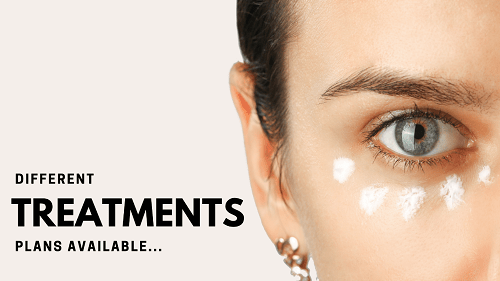Treatment
To treat dark circles, each condition have different treatment plans which are determined by the severity of the condition as well as the root cause. The first cause of action is to have a dermatology evaluation of cause and treat accordingly. Once your condition has been looked at, a combination treatment can be used.
Below are a list of typical treatments that can be advised, however without proper guidance from a dermatologist or a doctor, it is not advices to self-medicate.
- Topical depigmenting creams – containing hydroquinone, kojic acid, azelaic acid, arbutin, retinol, Vit C, E – some are strong effective but irritating in the delicate skin around the eye, so evaluation is required and treatment depending on skin type. Vit C retinol helps in skin thickening esp. in those with thin skin and visible vessels. Will list some creams below.
- Sunscreen – cannot emphasise enough the benefit of sunscreen in treatment and prevention of darkening, which should be chemical and mineral. UV coated sunglasses are also recommended.
- Chemical peels – if the cause is pigmentation – containing glycolic acid (GA), lactic acid (LA), trichloroacetic acid (TCA). They can cause post inflammatory hyperpigmentation if not done properly so need Dermatologist with expertise in treating skin of colour. In a study by Vavouli2, almost all patients treated with GA +TCA peel showed improvement. More effective than topicals but more side effects such as rednesss, burning sensation, itching. 1-3 treatments 4-6 weeks apart
- Laser – pigment lasers if there is pigmentation, especially dermal pigmentation, alone or in combination with creams – in a study3 15 out of 18 patients showed excellent to good results or ablative lasers – if wrinkles/ageing around skin. 1-3 Rxs 4-6 weeks apart
- Fillers – immediate results in those with tear trough deformity but temporary. Also area with risk of complications from fillers, including blindness, so only see an experience Derm or plastic surgeon for this area
- Platelet rich plasma (PRP) – recent treatment, relatively safe but can cause pain, swelling during and after treatment. Similar in efficacy to carboxytherapy. A study4 showed lightening in pigmentation, uniform colour, improvement in skin firmness and elasticity
- Carboxytherapy – subcutaneous injections of carbon dioxide – causes increased growth factor and new blood vessel formation and collagen repair. Still early days with uncontrolled studies only. Weekly treatment for 7 weeks to 1 year, showed 50-60% improvement in all patients, and found to be similar to peel and Vit C mesotherapy5
- Blepharoplasty – when caused by fat deposits or excess skin or due to structural problems or if above treatments fail.
References
- Sheth PB, Shah HA, Dave JN. Periorbital hyperpigmentation: a study of its prevalence, common causative factors and its association with personal habits and other disorders. Indian J Dermatol. 2014;59(2):151-157. doi:10.4103/0019-5154.127675
- Vavouli C, Katsambas A, Gregoriou S, Teodor A, et al. Chemical peeling with trichloroacetic acid and lactic acid for infraorbital dark circles. J Cosmet Dermatol 2013;12:204–9.
- Momosawa A, Kurita M, Ozaki M, et al. Combined therapy using Q- switched ruby laser and bleaching treatment with tretinoin and hydroquinone for periorbital skin hyperpigmentation in Asians. Plast Reconstr Surg.
- Mehryan P, Zartab H, Rajabi A, et al. Assessment of efficacy of platelet- rich plasma (PRP) on infraorbital dark circles and crow’s feet wrinkles. J Cosmet Dermatol. 2014;13(1):72–78
- Paolo F, Nefer F, Paola P, Nicolò S. Periorbital area rejuvenation using carbon dioxide therapy. J Cosmet Dermatol. 2012;11(3):223–228.
If you are suffering from dark circles and looking for someone to help you regain the vibrant looking skin or help with consulting on the best treatment bespoke to your condition? Then click on the below links to know more..


